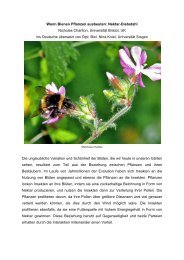PhDâ€theses - Ethologische Gesellschaft
PhDâ€theses - Ethologische Gesellschaft
PhDâ€theses - Ethologische Gesellschaft
Create successful ePaper yourself
Turn your PDF publications into a flip-book with our unique Google optimized e-Paper software.
SEXUAL CANNIBALISM: WHAT DO MALES HAVE TO OFFER?<br />
Sarah Deventer<br />
sari_australia@hotmail.com<br />
Research Update<br />
Diploma thesis, supervised by Prof. Dr. J.M. Schneider & Prof. M.E. Herberstein, Department of<br />
Biology, Zoological Institute & Museum, University of Hamburg<br />
The occurrence of sexual cannibalism is well documented, but why this extreme behaviour<br />
evolved in the first place is only partially known, and explanations are often species specific<br />
and not mutually exclusive. Some hypotheses incorporate the nutritional aspect of<br />
consumption of males. It is conceivable that conspecific males constitute a higher quality<br />
food for females than their usual diet due to the fact that males should hold nutrients which<br />
females of the same species also need, already in the right proportions. Moreover, males<br />
could contain essential nutrients that are absent in alternative prey or at least hold higher<br />
amounts of these desirable nutrients. A number of studies showed a positive effect of sexual<br />
cannibalism on female fecundity. However, it is not clear if this increased fecundity is only<br />
due to the fact that cannibalistic females gained additional food in those studies. Thus the<br />
question arises if females still retain a fecundity advantage when cannibalising a male<br />
compared to ingestion of a comparably sized other prey.<br />
The aim of this study was to compare female feeding rate between a sexual cannibalistic and<br />
a non‐cannibalistic feeding event, and, importantly, to assess how this translates into the<br />
eggs and spiderlings. We predicted a fecundity benefit (in terms of number and/or quality of<br />
offspring) from sexual cannibalism compared to consumption of comparably sized other<br />
prey.<br />
We found that spiderlings from females that consumed a male hatched slightly earlier, and<br />
started web construction sooner than from the control group. Three further offspring<br />
parameters (size, mass and survival duration under food deprivation) were positively and<br />
exclusively correlated to spiderlings’ lipid content. Although crickets hold more lipids than<br />
males and females took advantage of that, those three mentioned lipid‐dependent offspring<br />
parameters were not affected by whether the female consumed a male or a cricket.<br />
These results can be interpreted against, or in favour of the hypothesis that conspecific<br />
males constitute a high quality food for females. Nevertheless, these results show that males<br />
contain a different nutritional aspect than crickets (besides their lack of lipids) that<br />
influenced offspring. These differential effects are quite subtle, and not detectable in the<br />
commonly quantified measures of fecundity (egg sac weight or number of offspring). To our<br />
knowledge, this is the first study directly comparing the consequences of sexual cannibalism<br />
and a heterospecific feeding event on offspring, looking at offspring quality and behaviour.<br />
The results of this study extend the foraging hypothesis in relation to sexual cannibalism by<br />
adding the aspect of male nutritional content, and highlight the need for more research on<br />
the nutritional value of cannibalism, not (only) as an additional food source, but more<br />
specifically in comparison to the usual prey of females.<br />
11



